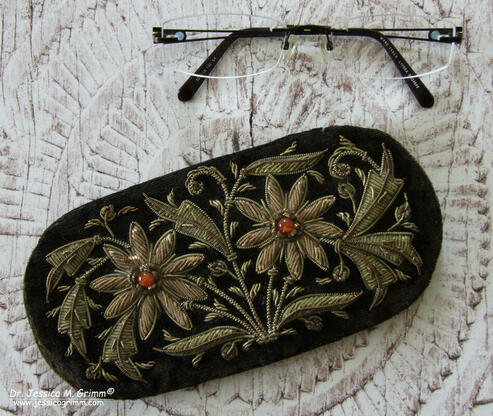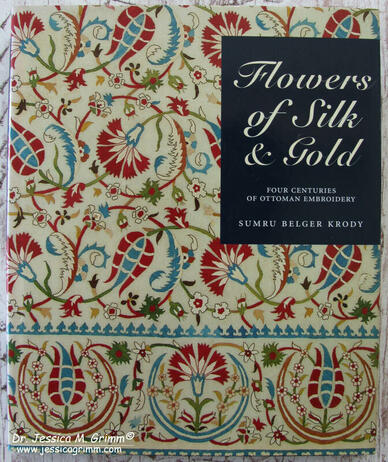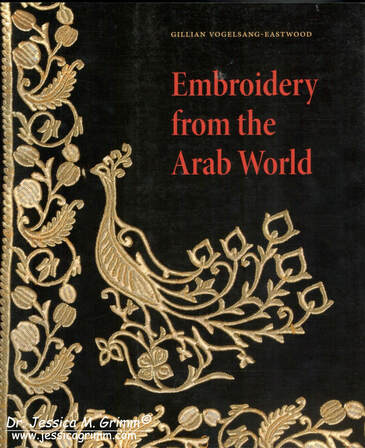|
Remember the two small black clutches with goldwork embroidery? One of my readers, Monica, suggested contacting the V&A in London to see if they knew some answers to my questions. I immediately wrote them an email. However, the autoreply I got stated that they generally don't do email consultations, but that I would be most welcome to bring my bags to a consultation day in London. Great was my surprise when I did receive an email back a couple of days ago! And this is what their Assistant Curator Jess had to say about my bags: "Many thanks for getting in touch and sharing the images of your bags. These appear to be what have become known as Zardozi bags, based on the Indian Zardozi embroidery technique, and were very popular in the mid-century. They also underwent a bit of a revival in 1980s, with many black velvet bags with vivid gold embroidery upon them in various designs, but usually in a standard size and rectangular shape. The quality and design of your bags suggest these are earlier examples, perhaps even the 1920-30's when exoticism in fashion was rife. I'd suggest these have been made for the tourist/export market, probably hand-worked but by a professional working on quite a mass scale." How cool is that? And Jess's answers explain a few things about the previous answers I got too. For starters, there is the confusion about the dating: 1920-30s, 1950s or 1980s. And as they were mass-produced in India it is small wonder that they are relatively unknown in the Netherlands. But since they were mass-produced, it is quite clear that your average flea market dealer is not going to tell you so even if they know :). Now that I had a name for this type of embroidery, I could search my books and the internet for more. By just typing 'Zardozi bags' into Google, I came across an image of something else my mum had acquired at a flea market: Yup, a glasses case made with Zardozi embroidery. So what is Zardozi? Looks like ordinary goldwork to me, you might think. Right! Zar means gold and dozi means work in the Persian language. The term Zardozi is used for traditional goldwork embroidery from Turkey, India, Pakistan, Bangladesh, Iran, Iraq, Kuwait, Central Asia and Azerbaijan. A browse through my needlework books resulted in a beautiful picture of Turkish goldwork in Mary Gostelow's "Embroidery: traditional designs, techniques and patterns from all over the world" published in 1977. As is usually the case with these overview books, there is not much additional information in the text. But lo and behold, my library contained two books with large sections on goldwork embroidery from the Ottoman Empire and the Arab World. The book 'Flowers of Silk & Gold: four centuries of Ottoman Embroidery' by Sumru Belger Krody describes the collection of the Textile Museum in Washington D.C. It is a beautiful book with in-depth chapters about the history of the Ottoman Empire, embroidery techniques and embroiderers and the designs and types of embroidered goods as well as a great catalogue of the collection. The book was published in 2000 and the pictures are really good; I highly recommend it if you are interested in Ottoman textiles! What does the book say on zardozi? It describes zerdüz (Turkish form of the Persian word) as an Ottoman embroidery using gold or silver wire or a braid and couching it down with a similar coloured thread. It is apparently similar to Ottoman dival embroidery. So what is dival embroidery? From the description, in the book, it becomes clear that this is gimped couching over cardboard padding. The design could be further enhanced with purls, sequins and pearls. I get the feeling that dival is seen as native to Turkey and zerdüz as foreign. The Ottoman Empire encompassed large stretches of Europe and Asia, so that is understandable. The last book with zardozi embroidery has been written by Gillian Vogelsang-Eastwood of the Textile Research Centre in Leiden. It is called 'Embroidery from the Arab World' and was published in 2010. This is an excellent book detailing the history of embroidery in this part of the world from the earliest examples in Egyptian Pharaonic tombs (early 14th century BC) to the modern era. With lots of background information on the history of the regions and social contexts of the embroidery and embroidered items. And the pictures are spectacular and come in great numbers. Another must-have for those of you interested in embroidery from this part of the world!
In this book, zardozi embroidery is called zari (metal thread embroidery). Badla is another form of metal thread embroidery associated with India, the Gulf region, Syria and Egypt. The later includes plate being used as a 'sewing thread' rather than being couched onto the fabric as is done in Western goldwork embroidery. As can be seen from the terminology above, there are many terms which refer to particular types of goldwork embroidery. This is due to the fact that 'the Arab World' stretches from Mauritania to Syria to Oman and Somalia. Regional differences are likely reflected in these terms. At the same time, as these distinct regions function within the cultural meta-system of the 'Arab World', techniques, materials and designs blend and influence each other.
12 Comments
Margaret Avril Baxter
15/4/2019 15:08:06
Fascinating article. Thanks for all your research
Reply
Mary Robins
15/4/2019 19:29:49
I am so glad you did get a reply from the V and A, I think our museum staff do great work which is rarely recognised. Thanks for the very interesting post.
Reply
Jeanette
15/4/2019 21:30:26
Jessica, what an interesting post. I’m glad that with help from the V&A you were able to solve the mystery and out a name to the embroideries.
Reply
15/4/2019 21:53:56
Me too, Jeanette! And it was particularly fun to find another piece in my collection :).
Reply
Nancy Anne White
16/4/2019 03:42:01
Magnificent embroidery in all of its names!
Reply
Catherine K.
17/4/2019 19:04:16
Hi Jessica, You have wonderful examples of that early embroidery style, which was executed so well it defies today's definition of mass-produced. Thoroughly enjoyed your detective work as you explained it in your post. I almost bought first book "Flowers of Silk and Gold" you mentioned on-line when it came out "all those years ago" and got a surprise when I saw the cover again. Now, with a lot more knowledge about Indian embroidery, I wish I'd bought a copy.
Reply
18/4/2019 16:48:51
Thank you Catherine! Yes, I kept feeling that my pieces were older than the middle or end of the 20th century. The metall threads are tarnished in a way the modern threads just don't do :).
Reply
Your comment will be posted after it is approved.
Leave a Reply. |
Want to keep up with my embroidery adventures? Sign up for my weekly Newsletter to get notified of new blogs, courses and workshops!
Liked my blog? Please consider making a donation or becoming a Patron so that I can keep up the good work and my blog ad-free!
Categories
All
Archives
July 2024
|
Contact: info(at)jessicagrimm.com
Copyright Dr Jessica M. Grimm - Mandlweg 3, 82488 Ettal, Deutschland - +49(0)8822 2782219 (Monday, Tuesday, Friday & Saturday 9.00-17.00 CET)
Impressum - Legal Notice - Datenschutzerklärung - Privacy Policy - Webshop ABG - Widerrufsrecht - Disclaimer
Copyright Dr Jessica M. Grimm - Mandlweg 3, 82488 Ettal, Deutschland - +49(0)8822 2782219 (Monday, Tuesday, Friday & Saturday 9.00-17.00 CET)
Impressum - Legal Notice - Datenschutzerklärung - Privacy Policy - Webshop ABG - Widerrufsrecht - Disclaimer









 RSS Feed
RSS Feed